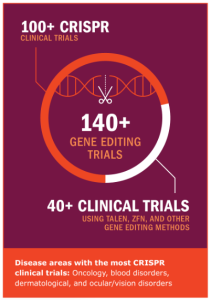 Regular readers of Alliance for Regenerative Medicine (ARM) sector reports may have noticed that the organization is taking a new approach to sharing insights on the cell and gene therapy sector. In April, ARM launched a new format for distilling key data and trend insights. Let’s delve into the key highlights from April’s inaugural Sector Snapshot report, which includes sector data from 2022, an outlook for 2023, and a summary of the gene editing “trends to watch.”
Regular readers of Alliance for Regenerative Medicine (ARM) sector reports may have noticed that the organization is taking a new approach to sharing insights on the cell and gene therapy sector. In April, ARM launched a new format for distilling key data and trend insights. Let’s delve into the key highlights from April’s inaugural Sector Snapshot report, which includes sector data from 2022, an outlook for 2023, and a summary of the gene editing “trends to watch.”
2022 saw significant regulatory milestones in the cell and gene therapy sector. Notably, three new gene therapies were approved for rare diseases, setting a new record. Three CAR T-offcell therapies (Lisocabtagene maraleucel a.k.a. Liso-cel, Axicabtagene ciloleucel a.k.a. Axi-cel, and Breyanzi) expanded treatment options for different types of cancers, with two approved as earlier-line treatments. Another ground-breaking achievement was the global approval of the first-ever “off-the-shelf” T-cell therapy.
Despite economic headwinds affecting financing, the sector remains poised for unprecedented progress in the coming year, with 2023 on track to bring forth a wave of advancements. In the United States alone, at least ten regulatory decisions are expected for various cell and gene therapies. This includes regulatory decisions for several gene therapies targeting rare diseases, along with two regulatory decisions on therapies for sickle cell disease, one of which could be – and many expect it to be – the first-ever CRISPR therapy approved.
Regulatory decisions are also expected on the first adoptive cell therapy for a solid tumour, and the first gene therapy for Duchenne muscular dystrophy. These developments point to the likelihood of cell and gene therapies reaching a growing patient population in the future, something which necessitates the readiness of health-care systems to ensure these therapies can be accessed by those who need them.
Gene editing takes centre stage
The inaugural Sector Snapshot highlights how gene editing, particularly CRISPR technology, is emerging as a game-changer in the cell and gene therapy sector. CRISPR trials have surpassed other gene editing approaches, such as ZFN and TALEN (which according to ARM were the dominant approaches in clinical trials until around 2018), demonstrating growing confidence in the promise of CRISPR gene editing approaches. The first regulatory decision for a CRISPR therapy, targeting sickle cell disease, is expected this year, marking a significant step forward in treating a larger patient population than previously approved gene therapies targeting rare diseases.
CRISPR is showing promising results in combating various blood diseases. Exacel, a CRISPR therapy developed by Vertex Pharmaceuticals and CRISPR Therapeutics for sickle cell disease, is up for approval in multiple regions including the United States and Europe. Other companies, including Editas Medicine and Intellia Therapeutics, are also advancing their CRISPR therapies for different blood conditions. The sector is also exploring different applications of CRISPR, such as in vivo treatments for ATTR amyloidosis (a rare, progressive disease) and Leber congenital amaurosis (a congenital eye disorder), which are already showing evidence of effectiveness.
As the sector continues to innovate, more advanced forms of gene editing are emerging. Base editing – enabling precise modifications to individual DNA letters in a sequence – is being tested in clinical trials for conditions like familial hypercholesterolemia (a source of heart disease). Early research is also exploring prime editing, capable of altering longer lengths of DNA, which could bring about comprehensive changes to disease-causing DNA. Epigenetic editing, another area of investigation, holds potential for controlling gene expression without making direct changes to the DNA.
Reading ARM’s Sector Snapshot, it’s clear that gene editing is no longer confined to the realms of science fiction. With ongoing research and mounting advancements, remarkable strides are taking place that are opening new doors for the treatment of various diseases. As we embrace this new era of precision medicine, it will be crucial to ensure continued collaboration, investment and regulatory support to unlock the full potential of these new therapies and ensure they reach patients in need. Here’s where to read the full Sector Snapshot report.
Cal Strode
Latest posts by Cal Strode (see all)
- World AIDS Day: Update on HIV cure research and gene therapies - December 1, 2025
- Headwinds and tailwinds for cell and gene therapy under the second Trump administration - March 11, 2025
- From innovation to international impact: ARM’s 2025 “State of the Industry Briefing” showcases maturing CGT industry - January 20, 2025







Comments